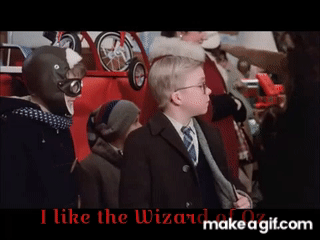
Posted on 08/20/2025 8:00:28 PM PDT by nickcarraway
Pink Floyd agrees.
I thought that was a myth.
Some movies…lots of Disney classics…I appreciate more with time…
It’s a Wonderful Life ditto.
For some reason Wizard of Oz doesn’t fill me with the same sense of wonder it did as a child. I can feel the corporate studio-ness of it all. And Judy Garland’s emotional baggage.
…For the first 40 minutes or so?
I’m still afraid of the flying monkeys.
Try Sergeant York.
As I’ve aged, I think Glenda was terrible for making her take that dangerous journey instead of telly her about clicking her heels together after she got the shoes.
It’s like she was playing a game and using Dorothy as her game piece.
She seems to have been a member of the political swamp.
This seals it, I am promising myself that I will finally watch the movie sometime this winter.

Helicopter parent? They have to grow up sometime.
Here's a breakdown of the common interpretations:
Dorothy: Represents the average American, particularly from the Midwest.
The Yellow Brick Road: Symbolizes the gold standard, the basis of the US monetary system at the time, according to some interpretations.
The Emerald City: Represents Washington D.C. or the power of money.
The Wizard: Often interpreted as a symbol of powerful political figures, particularly those associated with the gold standard, according to some analyses.
The Wicked Witch of the East: Represents the Eastern financial interests that controlled the gold standard. The Wicked Witch of the West: Represents the forces of nature that farmers struggled against.
The silver slippers (or ruby slippers in the movie): Represent bimetallism (the use of both gold and silver as currency), a key issue for the Populist movement. The Scarecrow: Represents the American farmer.
The Tin Woodman: Represents the industrial worker.
The Cowardly Lion: Represents William Jennings Bryan, a prominent politician who advocated for bimetallism.
The overall message, according to this interpretation, is that the common people (Dorothy and her companions) have the power to overcome adversity and create a better world, even without the help of those who seem to hold all the power.

“Myth, myth.”
“Yes?”
*Young Frankenstein
For entertainment purposes only:
https://www.looper.com/1468592/the-wizard-of-oz-theory-glinda-good-witch-actually-villain/
“As I’ve aged, I think Glenda was terrible for making her take that dangerous journey instead of telly her about clicking her heels together after she got the shoes.
It’s like she was playing a game and using Dorothy as her game piece.”
I see the witch of the North as guaroangel figure. She kept her safe and got her home. Dorothy had to learn the hard way to stop despising home and see it as a place she could grow. She was getting into danger. Getting too close to the real witch- Miss Gulch- annoying her, sending Toto into her garden; running away, getting into bad situations, getting caught in tornadoes, threatening her family’s safety
The 1925 version of The Wizard of Oz is available for free on Youtube. It features Oliver Hardy before he teamed up with Stan Laurel, and I like it better than the '39 version.
Having done this in college, I totally agree.
Disclaimer: Opinions posted on Free Republic are those of the individual posters and do not necessarily represent the opinion of Free Republic or its management. All materials posted herein are protected by copyright law and the exemption for fair use of copyrighted works.